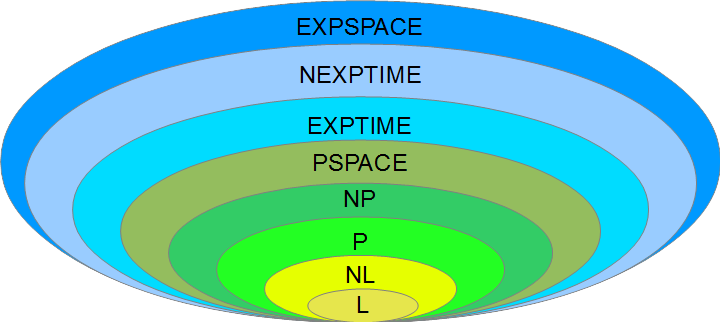Answer to Are some numbers more irrational than others?
The other answers and comments are fascinating, particularly about the irrationality measure, but allow me to give a little more information along the lines
of Mark Sapir's answer by mentioning that there are several
very large, intensely studied hierarchies of complexity for
reals numbers. After the initial familiar notions come
several others...
rational
algebraic
computable
The computable reals are those for which we can compute
rational approximations to any desired accuracy, by Turing
machine. (A concept used in computable
analysis.)
The computable subsets of $\mathbb{N}$ are those for which
we can compute yes/no answers for membership in finite
time. For example, all the numbers you mention in the
question, such as $\pi$ and $e$, are computable.
The c.e. subsets of $\mathbb{N}$ are those for which there
is a computable enumeration procedure. Equivalently, you
can compute the yes answers for membership in finite
time. The concept of relative (oracle) computability leads to the
hierarchy of Turing
degrees,
which measures the comparative computable complexity of a
real.
A real $x$ is arithmetic if it's digits can be defined by
a definition involving only quantification over the natural
numbers and primitive operations. Equivalently, the
arithmetic subsets of $\mathbb{N}$ arise from the
computable subsets of $\mathbb{N}^k$ by projection and
complement. The arithmetic
hierarchy
breaks naturally into levels, such as $\Sigma^0_n$ and
$\Pi^0_n$, corresponding to the logical complexity of these
definitions, and these levels are refined by the Turing
degrees. For example, the set of Turing machine programs
$p$ which compute total functions forms a complete
$\Pi^0_2$ set. The relativized notion leads to the arithmetic degrees.
A real is hyperarithmetic if it can be defined by two
equivalent definitions, one involving just one universal
quantifier over the reals and another having just one
existential quantifier over the reals, and otherwise any
level of arithmetic quantifiers. This is the same as
$\Delta^1_1$. The hyperarithmetic
hierarchy
is stratified in a hierarchy of length $\omega_1^{CK}$, a
lightface version of the Borel hierarchy, in which one uses
uniformly computable countable unions and complements. The
relativized notion leads to the hyperarithmetic degrees, a
hyperarithmetic analogue of the Turing degrees.
A real is projective if it can be defined by a
description that quantifies only over the set of real
numbers, plus natural number quantification and the
primitive operations. The projective
hierarchy
is stratified by considering the logical complexity of
these definitions, with levels $\Sigma^1_n$ and $\Pi^1_n$.
For example, the lightface analytic sets are $\Sigma^1_1$
and co-analytic is $\Pi^1_1$, with hyperarithmetic being
$\Delta^1_1=\Sigma^1_1\cap\Pi^1_1$.
A real is constructible if it exists in Gödel's
constructible universe
$L$.
The concept of relative constructibility gives rise to the
constructibility degrees, by which $x\sim y\leftrightarrow
L[x]=L[y]$, forming a rich hierarchy.
A real (or set) is
ordinal-definable
if there is a definition of it in the language of set
theory, using ordinal parameters. For example, the real
whose $n^{th}$ binary digit is $1$ just in case
$2^{\aleph_n}=\aleph_{n+1}$ is ordinal definable. The class
HOD of all hereditarily ordinal definable sets satisfies
ZFC, but can be strictly smaller than the universe of all
sets.
A real is generic over $L$ (or some other fixed universe
$V$) if it exists in a forcing extension of $L$ (or $V$) by
set forcing. Of course, it is relatively consistent with
ZFC that every real is generic over $L$, since this is true
in $L$ itself, but under some large cardinal axioms, there
are reals, such as $0^\sharp$, that cannot be added by
forcing over $L$.
The higher levels of these latter hierarchies are further
developed and stratified by the enormous variety of models
of set theory arising from large cardinals, various inner
model constructions, forcing extensions and so on, so that
the hierarchy loses its linear nature, becoming instead a
dense jungle of various interacting concepts of set theory.



